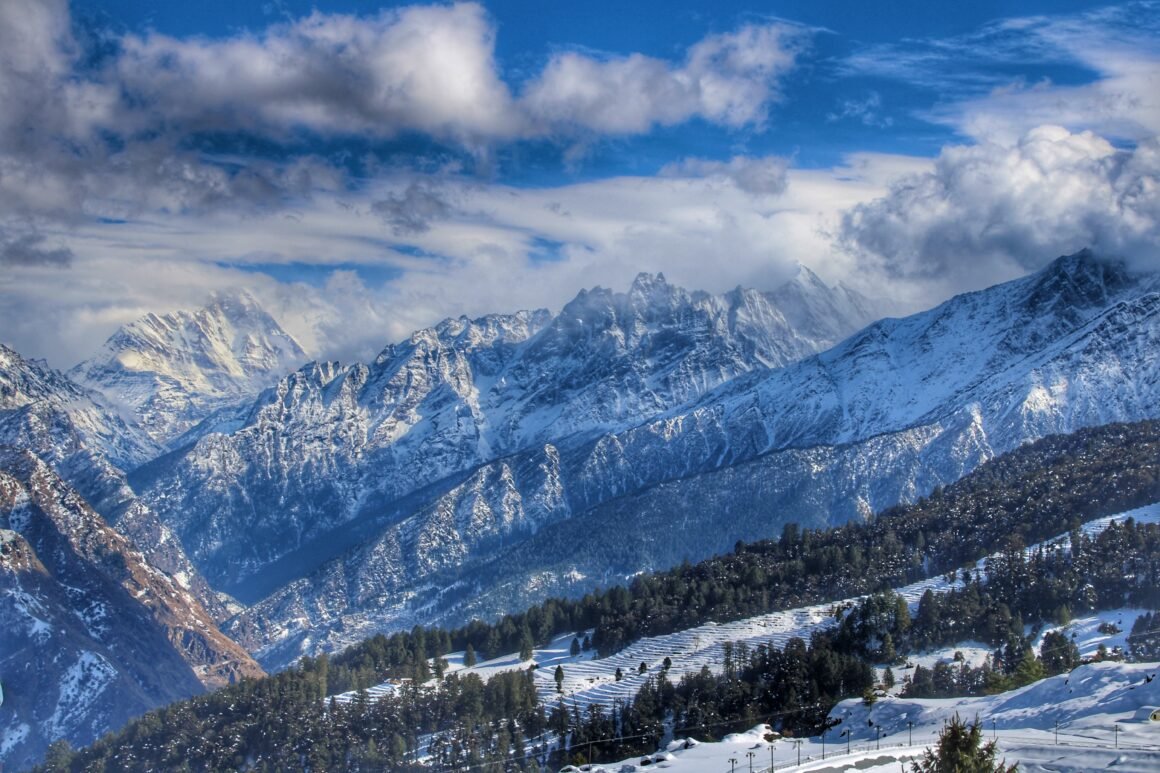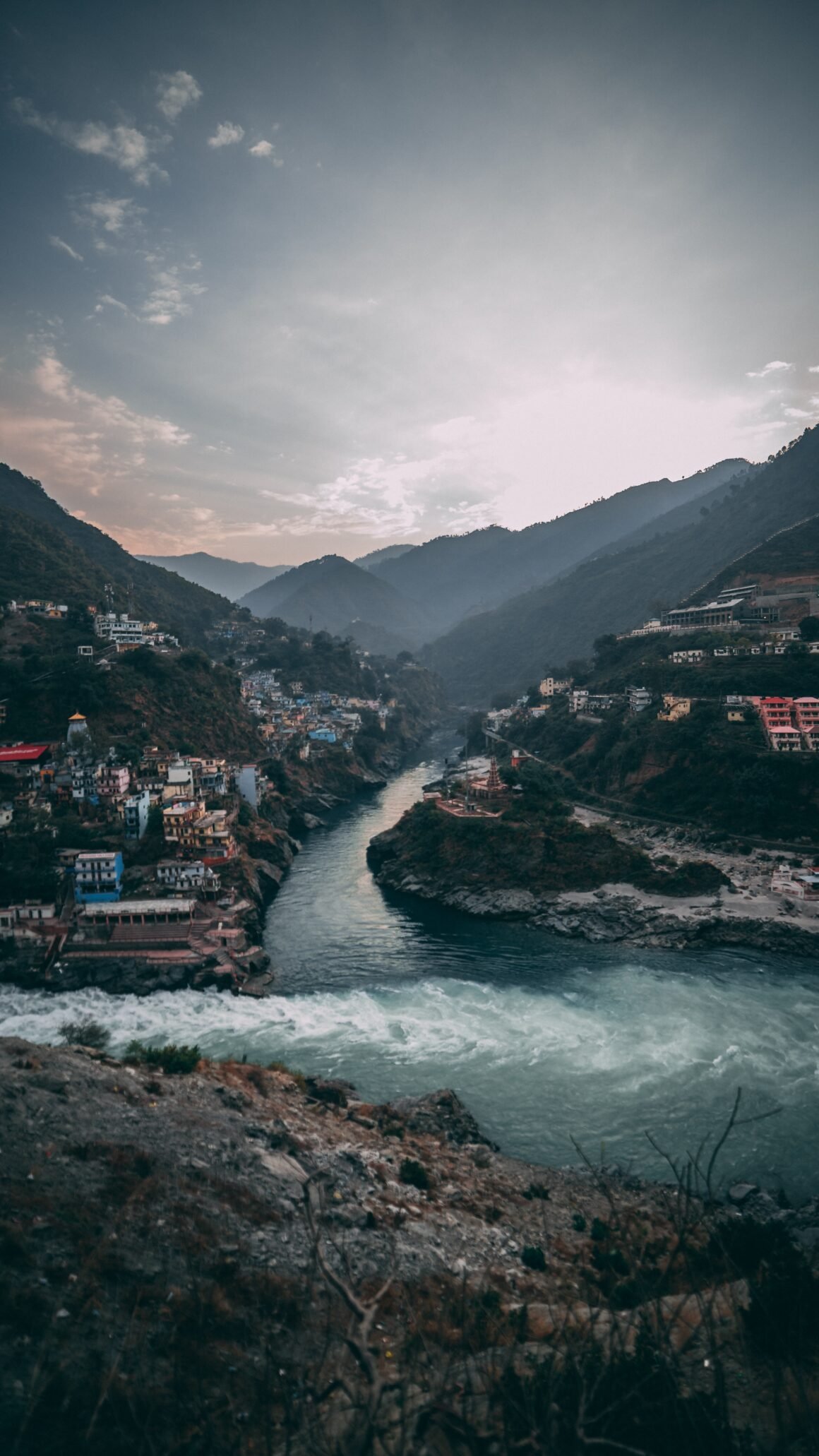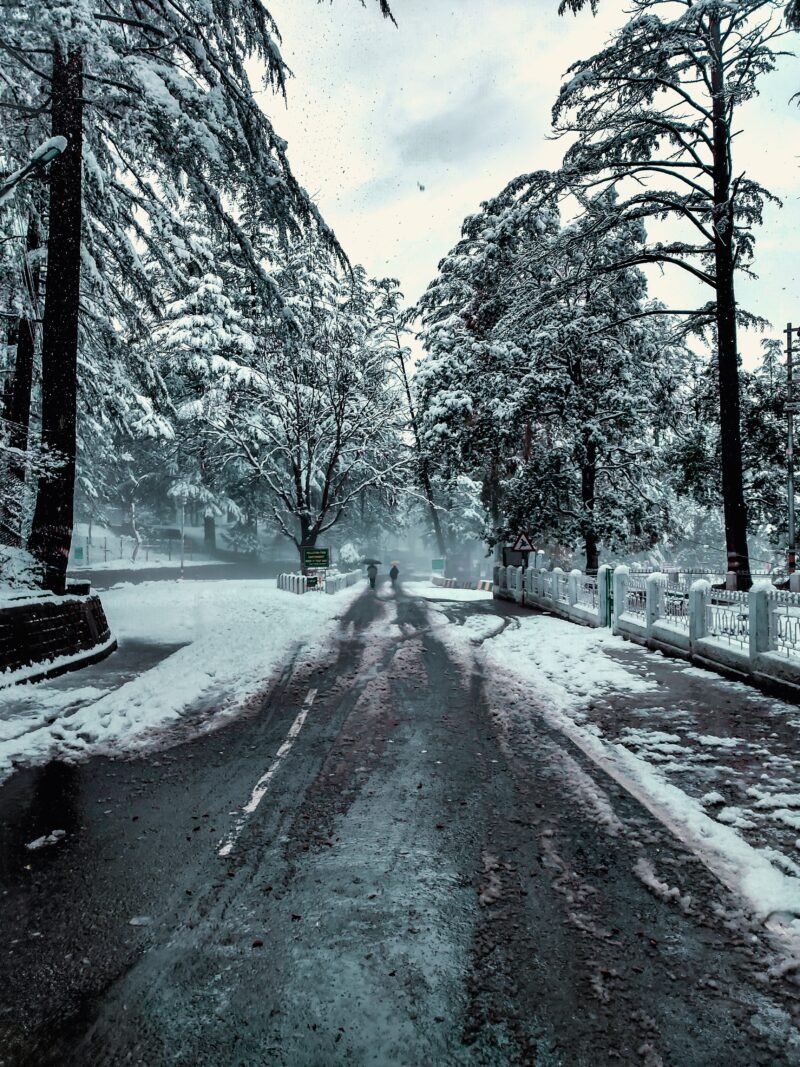The enchanting land of Uttarakhand, with legends of Lord Shiva, Guru Gobind Singh and goddess Nanda Devi, has all the Himalayan assets—numerous snow-clad peaks, enchanting rivers and glacial lakes, ancient shrines, ski slopes, beautiful hill stations, a national mountaineering institute, camping meadows, hundreds of trekking trails and above all a government determined to turn it into a Switzerland of India.
In 1988, to boost adventure-tourism to the erstwhile Uttaranchal, with the help of the Indian Mountaineering Foundation and Air India, I organized ‘The International Mountaineering and Tourism Meet’ in Mussoorie. It is an interesting coincidence that at this Meet Shri N.D. Tiwari, then the Chief Minister of U.P., was the chief guest. Again after a gap of 17 years, when these Meets were being revived by the initiative of the ‘Himalayan Environment Trust’, Tiwariji, now Chief Minister of this new Himalayan State of Uttarakhand, would preside once again over this Meet. This paved the way for the systematic development of adventure tourism in the State.
During my 50 years of climbs, excepting three Indian expeditions to Everest and one each to Annapurna-III in Nepal and one to Saser Kangri in Karakorams, my remaining 10 major expeditions were in the present Uttarakhand. These include expeditions to Nanda Devi – both East and West – Nanda Kot, Trisuli and an exciting trip up the Ganges “From Ocean to Sky” using jet boats, with Sir Edmund Hillary.
Uttarakhand, comprising the Garhwal and Kumaon Himalayas, interlocked in an eternal embrace that in the adventurer’s eye, all demarcating lines disappear, making it difficult to discover where one ends and the other begins. The single uniting factor is the snowline that runs along the horizon in the north like a golden wave, west to east. No surprise, our ancestors divined in this scrawl the signature of God and named it as Dev Bhumi, Land of Gods.
The Survey of India, in its scientific division of the Himalayas, called this slice of territory the Kumaon Himalaya obviously because the Kumaon mountains predominated in the Surveyor’s elongated eye. Kenneth Mason in his celebrated book Abode of Snow describes:
“The Kumaon Himalaya is bounded by the Sutlej on the West and North, and by the Kali (at Mahakali) on the east, which here forms the western boundary of the Independent State of Nepal. In its passage through the Siwaliks at Tanakpur, the Kali becomes the Sarda river of the Gangetic plain before joining the Gorgra in the old province of Uudh. Left-bank tributaries of the Sutlej, chief of which are the two extremities of the region. Between them are the Himalayan basins of the Jamuna – with its source near Bandarpunch and its right-bank affluent of the Tons; of the mountain feeders of the sacred Ganges – Bhagirathi, Mandakini, Alaknanda, and Pinder; and the small Ramganga, which drains the Lesser Himalaya in the districts of Almora and Nainital.”
Topographically, Uttarakhand like Kashmir and Himachal, reveals the same unmistakable architectural pattern: three giant steps. The first begins as you enter from the plains of subtropical Shivaliks (the lower hills). Next, you step into the lush-green valleys and the lesser (or inner) Himalaya, beyond on the third step, lies the barren grandeur of the outer Himalaya, the towering wall above the lush plains of the Ganges.
Instead of straining ears to catch echoes from the Puranic past extolling the fabulous beauty of Uttarakhand, thereby stretching your credence too far, you may better listen to what recent foreign explorers have said of this land. Tom Longstaff has this to tell you:
“After six visits to the snows, I still believe that Uttarakhand is the most beautiful country of all high Asia. Neither the pristine immensity of the Karakoram, the aloof domination of Mt. Everest, the softer Caucasian beauties of the Hindukush, can compare with Uttarakhand. Mountains and valleys, forests and alp, birds and animals, butterflies and flowers, all combine to make a sum of delight unsurpassed elsewhere.”
Another extraordinary Englishman, Frank Smythe, who made several happy journeys in Uttarakhand, said in the same vein in his famous work The Valley of Flowers:
“Is there any region of the Himalayas, or even of the world which excels this region in beauty and grandeur? Where else are to be found such narrow and precipitous valleys and gorges, such serene vistas of the alp, forest, snowfields and peaks? This ‘Abode of Snow’ is rightly the goal of the heat-enervated people of the plains. Never was there a pilgrimage of finer accomplishments. It is the perfect antidote to a static life, and it cannot fail to inspire in the dullest a noble conception of the Universe”.

Perhaps Dr Paul Bruton, the modern hermit in the Himalayas, who ensconced himself in the heartland of Garhwal, paraphrased all the poetry composed down the ages in praise of the incomparable beauty of Uttarakhand and compressed essence in a single sentence:
“The Gods who made this land must have been beauty drunk.”
The thing to be remembered about Uttarakhand is that it is a variegated land. To savour the full perfection of its beauty, one has to explore it in its greater variety and depth. Depth, yes, as otherwise, you would be not unlike that bird-watcher who is fascinated by the plumage and forgets to watch its owner.
As you set your sights, a breathtaking spectacle settles before your vision-cyclopean mountains, range beyond range, stride away into the horizon along white highways of glacial ice. Your eye may miss the skyscrapers of neighbouring Nepal but the grandeur is there, opulence on a grand scale. The magic of seven thousand and six-thousand-meter-high mountains fills the panorama around. Superlatives roll off your tongue as you begin to identify and single out peak after peak. In the Zaskar range, dividing India from Tibet, you see the majestic Kamet glowing golden, morning-evening, reflecting the fires its surrounding glaciers burn with. Then, its satellites – Abi Gamin, Deoban, Mukut Parbat and Mana – reveal themselves. Towards the East, the Great Himalayan range lies studded with such rare gems as Nilkanth, (Frank Smythe described it as the Queen of Mountains because of its anatomical symmetry), Satopanth (pathway to truth) and Chaukhamba (four mighty pillars on which rests the throne of Badrinath). Further southwards your eye would encounter a lovely vision of the Sky-Goddess Nanda rising to her full stature, announcing her presence in the fascinating realm she rules over, an acknowledged masterpiece of wilderness not found anywhere in the world, showing such lovely jewels from her treasure trove as Dunagiri (a high lance of ice thrown in the sky, raking the very edge of space), Mount Trisul (the three-headed guard of the Goddess), Changabang (the shining mountain – ‘a sheer precipice a granite floating in the air). Then there is an inescapable Panchchuli (gleaming indeed like the ‘five kitchen fires’ of the five Pandava brothers, heroes of Mahabharata). Your roving eye would not of course miss the Trisuli group with Hardeol (God’s lamp) holding its own.
Glance down the second Crest Zone and your astonished eye would find a cascade of gleaming diamonds – Bandarpunch (monkey’s tail), Swargarohini (pathway to Heaven Pandavas are supposed to have followed), Sudarshan (Lord Krishna’s ultimate weapon), Srikanta and so on. On the Gangotri chain shimmer more rare gems – Shivling (Bonington’s fairy-tale mountain), Thaley Sagar, Meru, Kedarnath, Bhartekhunta, Kharchakund, Bhagirathis, Gangotri group and countless others. The constellation is endless, and so is fascination.
Mountains are there in a generous measure elsewhere too in the Himalayas but what is delectably different in Uttarakhand is the revelation the effulgence emanates not because of the incredible concentration of high mountains sheathed in snow and ice crowding the landscape but from the names given to them, to the Surveyors, after epical legendary heroes and heroines. Your sense of mythology and history of the land comes alive. You do not just see mountains but a galaxy of the great. The peaks take on a beauty not noticed before.
It is undeniable that snows provide cosmetics and glamorize the mountain-scape. The snow do not only cover the naked giants with ice robes but also vests them with awesome immensity adding to their verticality and sharpening the edge of altitude. But the way snows weave their web and create a multi-dimensional adventure arena in Uttarakhand outsteps imagination. Just see. Hundreds of mountains, hundreds of glacier robes! For millions of years, billions of snowflakes have fabricated these glacier garments. As is their wont, mass and gravity have kept tugging and pulling at these hundreds of robes, rumpling them, ripping them apart in the process. Wind and sun, the eternal sculptors, have been at work, carving out curves and contours – classic features that give each mountain its identity. Heat and cold, Nature’s other instruments, weaving weather, have created hurdles and hazards, arming each mountain. So, you see, hundreds of mountains vie with each other in announcing varying challenges to attract admirers and aspirants wanting to climb up them.
Then, the snow magic moves with the moving glaciers. Hundreds of glaciers descending down, run like rivers of ice, advancing, spreading, swamping over whatever comes in their way, miles upon miles. Why the beauty of the snow turns into fantasy! The glacier spread in Uttarakhand is stupendous. Let’s look back at the Zaskar range and down the upper Crest Zone. Paschim (West) Kamet glacier begins its march from Mukut Parbat (7242 m) and ends at Khati, a run of 15 km, collecting its tributaries – Uttari and Dakshini Chamirao and Khagyan glaciers. The Purvi (East) Kamet glacier, starting from Yavigamin Peak (7355 m) stops at Dobal after a 12 km run holding Raykana, Uttari Raykana and Ganesh glaciers in its embrace. From Gupta-Peak (5807 m), Bonkund glacier flows for 15 km to Mulya bank sweeping along 10 big and small babies –Devban, Nagthuni, Uttari and Dakshini Nagthuni, Semkhrak, Andardip, Khuliyagamya, Kosa, Raj, Dumagiri and Tipra (9 km) glaciers. Bhagirathi Kharak begins its roll from a 6984 m peak and never looks back till Basudhara is 17 km away. Similarly, Satopanth glacier sweeps the floor for 12.5 km from a 6864 m peak lashing its tail at Basudhara. Panpatia glacier goes 12.5 km
from 6974 m dissolving 2.5 km upstream of Khirganga, seizing its tributaries – Grime, Kalapani and Puna glaciers. Arwa glacier originates from a 6291 Peak, picking its tributaries – Vidun and Bagni glaciers spread for 12 km to the north of Arwa Pahar (5873 m). Down in the Lower Crest Zone, Bandarpunch glacier, originating from Batiakhund Bamak (6291 m Peak), disgorges Tons river after a 9 km run. Surprisingly, the longest (25 km) of all icy craters is the Gangotri glacier that descends from the height of 7138 m from the NW slopes of Chaukhamba peaks and with no holds barred, surges along picking Chaturangi glacier in a glaucous gait.
This is not the whole story. The long and short of it all is that Uttarakhand is one of the most glaciated regions and the glacier maze is the most amazing. What we are trying to say is that taken together glaciers create a nacreous paradise not only for mountaineers but high altitude trekkers, scientists and above all skiers – especially, because untried, unexplored stretches lie waiting. But wait, the denouement in the glacier story, most stunning at that, comes only now.
Among the legends that have descended down the ages, the loveliest is the one about the descent of Ganga from the heavens to the mattered locks of Lord Shiva, presiding deity of the Himalayas, and thence down to earth to complete its sky to ocean run. But the reality is far more fascinating, the descent much more dramatic than the fable.
High up in the Upper Crest Zone from the ice caverns of Satopanth and Bhagirathi glaciers, the melt waters trickle. Like toddlers, they start on their exploratory walk as if in trance not realizing the role they are destined to play. Then, frightened out of their cradle beds by massive frozen bergs and tones of slabs and soft snow sweeping down the mountain slopes, they leap into each other’s embrace and become a babbling stream. A similar metamorphosis takes place elsewhere too. A miracle follows:
The joint stream, flowing fast and furious, reaches Alkapuri, the place where Kuber, the God of Wealth, resides, sitting pretty on its hidden wealth, and assuming a common name, Alaknanda. After about 8 km, to the east, they are joined by Saraswati which comes screaming from the Mana Pass, throwing its lot with Alaknanda, willingly losing its own identity, marking the confluence at Keshavprayag. Further down, Bhuinder Ganga flows in and empties itself into Alaknanda at Pandukeshwar Khir Ganga follows suit. At Badrinath, Rishiganga too makes a common cause with the all-boarding Alaknanda. More the merrier. At Joshimath, Dhauli Ganga, careering all the way from Kamet glacier, flings itself into Alaknanda’s arms striking the confluence at Vishnuprayag. Nandakini, flowing from the glacier near Nanda Devi, surrenders itself to the now swelling river, Alaknanda, at Nandprayag. Pindar river from the Pindari glacier too embraces Alaknanda at Karanprayag. Mandakini, from the majestic Kedarnath, pays its homage at Rudraprayag. Then, at Deoprayag, bloated Alaknanda decides to bow out of the merger race, and does penance by committing itself to Bhagirathi’s care, the latter rushing down from Gaumukh and glorifying the vent by assuming the name Ganga.

So you see, it is not just the descent of a mighty river from the sky, it is a dramatic river rally – several daughters of the mountains roaring out of the mighty mountains lifting all their own tributaries on their way, rumbling, tumbling in their headlong run to the ocean, hating to be harnessed, cutting their way through granite gorges, meandering for miles upon miles through valleys, now narrow, now broad, all the while orchestrating a raucous mountain melody that heard close by strikes awe in a mortal’s mind but from distance resounds like the recitation of purest poetry of the Vedas, Song Celestial, over bucolic banks, through the valleys and across the hills. In the deafening raucous roar, an adventurer hearkens to an unmistakable call and discovers a fascinating arena bristling with possibilities more exciting than mountain climbing. Those who read rivers say that this mighty torrential flow incontestably makes one of the world’s wildest white water stretches. Between Joshimath and Deoprayag alone, the waters rush down 5000 feet, full of froth, bouncing, blundering, tripling, executing leaps and somersaults over big boulders and rocks, forming waterfall, whirlpools, rapids, rollers and cold cauldrons of seething cataracts, couched in the setting of stunning scenery. A white water adventure connoisseur fancies in this fantastic flow many epic expeditions ever undertaken by man.
What we have witnessed thus far is only half the adventure meant for those who are made of sterner stuff. The other half stalks lower down – in the hills, forests, streams – where Alpine wonder with rainbow provocations dwell. For a trekker and a hi-fi walker, there are countless vertical and horizontal trails that bring one into contact with glades and glens, forests and meadows, hills and waterfalls – nature’s show- windows. For a wildlife lover, the richness and variety of fauna are fabulous as could only be found in a book of fairy tales.
For a beauty watcher, there are innumerable sequestrated haunts consecrated by nature to the worship of beauty where one can find, as Symthe did in the Valley of Flowers, a “sanctuary for spiritual rejuvenation.” For a pilgrim who holds the credo, like Brunton, that in life “it does not matter that matters”, there are endless avenues that lead to the very edge of stillness, yet make the silence articulate.
For an anthropologist, a constellation of culture lies squeezed in the hills – in sacred shrines, in the ancient seats of religion and culture, at river confluences, in fairs and festivals, in the colorful life of the simple hillfolk to whom folklores captured in song and dance are like heartbeats. There is no hillside, no village, no valley, no mountain, that’s without some sacred memory or which is not associated with some God, some celestial being, some sage, some saint, some hero, some heroine of mythology.
Lakes, waterfalls, streams and rivers lend animation to the landscape. Seasonal monsoons bring magic – primaeval forests get their wash and gleam greener. Spring and autumn carry their own basketfuls of flowers of every blush and tint transforming everything into a cornucopia of colours.
And the rhythm of night and day at the display – spilling of colours at sun-up and sun-down, sunbeams breaking through the prisms of snows and ice during day-time – spraying all the colours of the rainbow and hanging threads and bands of light, festooning distances with little suns. And above everything else, the all-pervading purple haze and the sound of music vibrating the air with joie de vivre!
Such is Uttarakhand, the elevated world far beyond the imagination of Man. You have to see it and feel it. And its astringent influences will steal over you, suffuse you and convince you that it is no less exciting than Switzerland.






